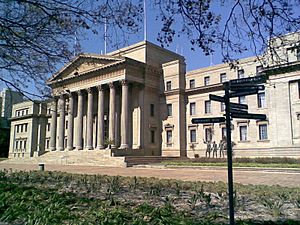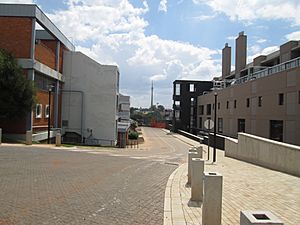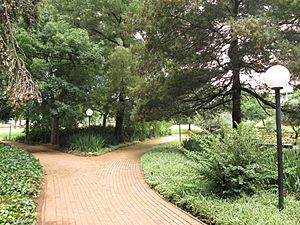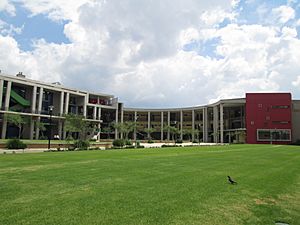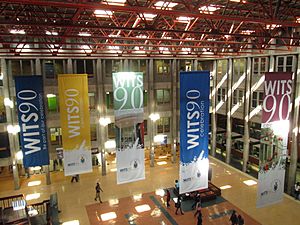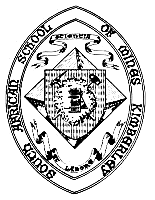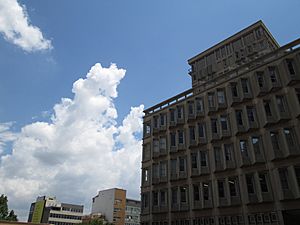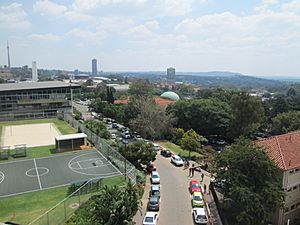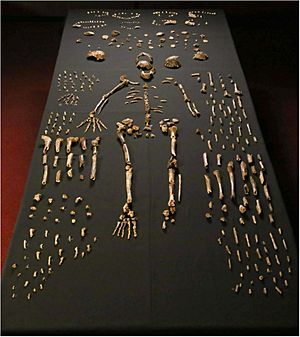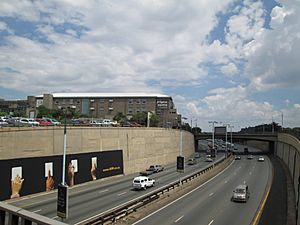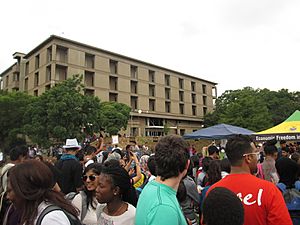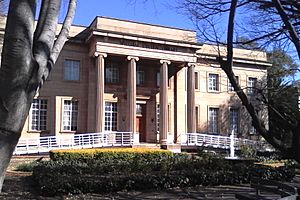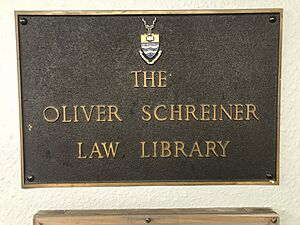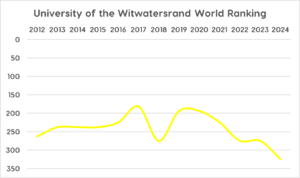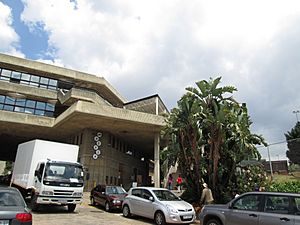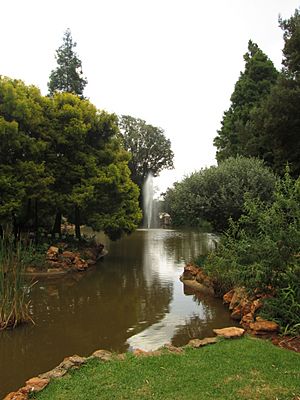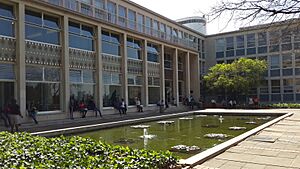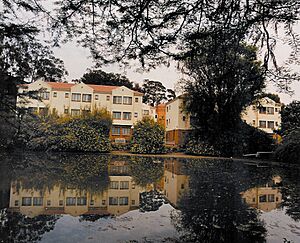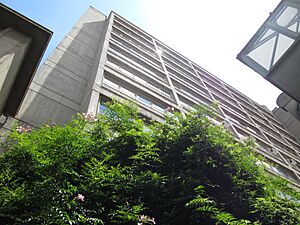University of the Witwatersrand facts for kids
|
Universiteit van die Witwatersrand (Afrikaans)
|
|
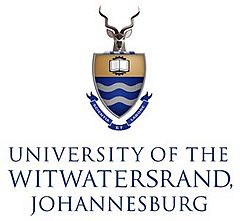 |
|
|
Former names
|
South African School of Mines (1896–1904), Transvaal Technical Institute (1904–1906), Transvaal University College (1906–1910), South African School of Mines and Technology (1910–1920), University College, Johannesburg (1920–1922) |
|---|---|
| Motto |
Scientia et Labore (Latin)
|
| Type | Public university |
| Established | 1922 |
| Affiliation | AAU, ACU, FOTIM, HESA, IAU |
| Chancellor | Judy Dlamini |
| Vice-Chancellor | Zeblon Vilakazi |
| Chairman of Council | Isaac Shongwe |
|
Academic staff
|
1,112 (Full-time, Permanent) |
| Students | 40,259 |
| Undergraduates | 25,352 |
| Postgraduates | 14,025 |
| 2,153 | |
| Location |
,
,
26°11′27″S 28°1′49″E / 26.19083°S 28.03028°E |
| Campus | 2 urban and 3 suburban campuses |
| Colours | Blue Gold |
| Nickname | Wits |
| Mascot | Kudos Kudu |
The University of the Witwatersrand, Johannesburg (often called Wits University or just Wits) is a big public university in Johannesburg, South Africa. It's a place where students learn and researchers discover new things. The university started because of the mining industry, just like the city of Johannesburg itself.
Wits began in 1896 as the South African School of Mines in Kimberley. It is the third oldest university in South Africa that has been open continuously.
As of 2025, Wits has about 37,295 students. Around 20% of these students live in the university's 17 dorms. Most students (63%) are studying for their first degree, while 35% are doing advanced studies after their first degree. In 2024, Wits received 140,000 applications but could only accept about 6,300 students. This means it's quite a competitive university to get into!
Contents
A Look at Wits University's Past
How Wits Began: 1896 to 1922
The university started in Kimberley in 1896. It was first called the South African School of Mines. It's one of the oldest universities in South Africa.
In 1904, the school moved to Johannesburg and was renamed the Transvaal Technical Institute. Its name changed again in 1906 to Transvaal University College. Later, in 1908, a new part of this college opened in Pretoria.
On May 17, 1910, the Johannesburg and Pretoria parts became separate schools. The Johannesburg campus was renamed the South African School of Mines and Technology. The Pretoria campus later became the University of Pretoria. In 1920, the Johannesburg school was called the University College, Johannesburg.
Becoming a University: 1922 to 1959
Finally, on March 1, 1922, the University College, Johannesburg, became a full university. It was named the University of the Witwatersrand. The city of Johannesburg gave land in Milner Park for the new campus. Building started on October 4, 1922.
The first leader of the new university was Prince Arthur of Connaught. The first Principal was Professor Jan Hofmeyr. He believed that universities should be open to everyone, no matter their background. Wits followed this idea from the start, welcoming students of all races.
At first, Wits had six main study areas: Arts, Science, Medicine, Engineering, Law, and Commerce. There were 37 departments, 73 teachers, and about 1,000 students. In 1923, the university started moving to its new campus. The Prince of Wales (who later became Edward VIII) officially opened the main building in 1925.
In 1931, the university's first library burned down. People donated money to build a new one, the William Cullen Library, which opened in 1934. Even during tough financial times, Wits grew quickly. By 1945, it had 3,100 students.
During World War II, Wits helped with South Africa's war efforts. Its research institute helped with important work on radar.
In 1948, a new government came to power and started apartheid. This was a system of unfair separation based on race. Wits, along with other universities, spoke out against apartheid. They believed in university freedom and fairness for all.
In 1959, the apartheid government passed a law that limited black students from joining most universities. Even so, many important black leaders studied at Wits. The university strongly protested these laws and continued to stand against apartheid. This led to a time of disagreement with the government. Wits became open to all races again in 1990, before apartheid ended. Many people who spoke out against apartheid had studied at Wits.
Growing and Standing Against Apartheid: 1959 to 1994
Wits kept growing, from 6,275 students in 1963 to over 16,400 by 1985. This meant the university needed more space. New buildings and campuses were added.
In the 1960s, Wits bought a famous limestone cave called Sterkfontein. This cave is known for its very old human-like fossils. Another nearby farm, Swartkrans, also rich in fossils, was bought in 1968.
The 1960s also saw many protests against apartheid. Police often came onto campus to stop peaceful protests. Some students and staff were even banned or arrested. The government cut funding to Wits, sending money to other universities instead. Despite this, Wits continued to grow and fight for its beliefs.
In the 1970s, new buildings like the Jubilee Hall and Wartenweiler Library were built. The university also opened the Tandem Accelerator, a special nuclear facility. In 1977, Senate House, the main administration building, was finished.
The 1980s were a time of big expansion for Wits. The Medical School moved to a new location in Parktown in 1982. In 1984, Wits bought the Milner Park showgrounds, which became West Campus. The original campus became East Campus. A large bridge, the Amic Deck, was built to connect East and West Campuses over the highway.
During the 1980s, Wits continued its strong opposition to apartheid. The university stood firm on its commitment to freedom and fairness. Even though the government tried to control Wits by threatening to cut money, the university protested.
A research project in 1986 showed that many people outside Wits saw it as a university mainly for white people, even though Wits saw itself as fighting apartheid. This led to discussions within the university about how to change and become more welcoming to everyone.
Despite these internal discussions, the university community generally kept fighting apartheid. Many protests happened on campus, often leading to police coming in. In 1990, when Nelson Mandela was released from prison, students unofficially renamed a lawn on East Campus "Mandela Square."
Wits Today: 1994 to Present
In 2000, Wits started a plan called "Wits 2001." This plan changed how the university worked. Some jobs, like cleaning, were given to outside companies. The university also reorganized its academic departments, reducing the number of faculties and schools. Wits tried to help affected employees by offering early retirement and bursaries for their children who were studying at Wits.
This plan caused some disagreement, with workers and students protesting. However, the university said these changes were needed to help Wits be financially strong and offer better services in the 21st century.
In 2001, the Johannesburg College of Education joined Wits, becoming the Wits Education Campus. In 2003, a student mall called the Matrix opened on East Campus.
From 2015 to 2016, the FeesMustFall movement saw students protest about university fees at Wits and other South African universities. In March 2021, there was a protest at the Braamfontein campus because students who owed a lot of money were not allowed to register. The university said it was owed over a billion rand in unpaid fees and needed to be financially stable. Wits has also partnered with companies to offer online courses to help with funding.
In 2022, Wits celebrated its 100th birthday! As part of this celebration, Wits has been working to help students who are called the "missing middle." These are students who are not poor enough for full government help but are too rich for other types of aid. Wits received a large donation of R150 million from a former student, Natie Kirsh, to help these students. However, student debt is still a big challenge, with students owing Wits more than R3.5 billion in unpaid fees as of May 2024.
Wits University's Coat of Arms
The university's coat of arms (its special symbol) was designed in 1972. It has a gold background at the top, representing the gold fields of the Witwatersrand, which is where the mining industry that started the university came from. On top of the gold, there's an open book and a cogwheel, showing knowledge and hard work.
The wavy silver lines at the bottom represent the Vaal and Limpopo rivers. Above the shield is the head of a Kudu, an antelope found in the area and the university's mascot. The university's motto, "Scientia et Labore", means "Through Knowledge and Work" in Latin.
This coat of arms developed from the old badge of the South African School of Mines. That badge had a diamond with a shield on it, showing mining tools. Its motto was the same as Wits's current one.
How Wits is Run
Wits is managed by a group called the Council. The Chancellor is the ceremonial head who gives out degrees. The Vice-Chancellor is in charge of the university's daily operations and reports to the Council. The Council chooses all the main leaders of the university.
The Senate is responsible for all teaching, research, and academic activities. Students also have a voice through the Students' Representative Council (SRC), which sends representatives to the Senate and Council.
Wits Campuses
Wits has five main academic campuses. The main one is East Campus. Right across the De Villiers Graaff Motorway is West Campus. A brick bridge called the Sibanye-Stillwater Bridge connects them.
East and West Campus are like one big campus. East Campus is mostly for Science and Humanities studies, and it's where the main university offices are. West Campus is home to Engineering, Built Environment, Commerce, Law, and Management studies. Both campuses have student dorms.
Wits has three more academic campuses in Parktown.
- The Wits Education Campus (WEC) is for education studies. It has three female dorms.
- The Wits Medical Campus is for Health Sciences.
- The Wits Management Campus has the Wits Business School. It also has dorms.
There are also other student residences in the city area of Braamfontein and Parktown.
Special Places at Wits
Heritage Sites and Objects
The University of the Witwatersrand has two provincial heritage sites and two heritage objects.
- The Great Hall (the front of the Robert Sobukwe Building) is a heritage site.
- The Dias Cross in the William Cullen Library is also a heritage site.
- Jan Smuts' study, located in Jan Smuts House, is a heritage object.
- The Paul Loewenstein Collection of rock art is another heritage object.
All these special places are on East Campus.
Wits Institute of Social and Economic Research (WiSER)
Wits is home to WiSER, a research center started in 2001. It focuses on social and economic studies.
Cradle of Humankind
Wits acquired the Sterkfontein and Swartkrans sites in the 1960s. These sites are famous for very old human-like fossils. In 1999, this area was named a World Heritage Site by UNESCO and called the Cradle of Humankind. Wits's archaeology and palaeontology departments still play a big part in digging up and studying fossils there. Professor Lee Berger discovered Australopithecus sediba (2010) and Homo naledi (2015) at this site.
Wits Museums
The university has at least fourteen museums! These include the Adler Museum of Medicine, the Palaeontology Museum, and the only Geology Museum in Gauteng Province. You can see amazing things like the Taung skull, different dinosaur fossils, and even butterflies.
Johannesburg Planetarium
The Johannesburg Planetarium was the first full-sized planetarium in Africa. It opened on October 12, 1960. It's used to teach students about space and is also open to the public. People often ask the Planetarium to explain unusual things seen in the sky over South Africa.
Wits Art Museum
The Wits Art Museum started collecting art in the 1950s. It has grown a lot since then. In 2012, the new Wits Art Museum opened, showing off its amazing collections, including one of the best collections of African beadwork in the world.
Wits Theatre
The Wits Theatre is a place for performing arts at the university. It hosts shows for students and professional groups.
Wits Centre for Diversity Studies (WiCDS)
The Wits Centre for Diversity Studies (WiCDS) was started in 2014. It helps people understand and deal with the challenges of diverse societies, especially in post-apartheid South Africa.
What Wits Teaches and Researches
Research at Wits
Wits University is a leader in research. It has many top researchers and special research centers. Many of its researchers are considered "international leading scholars" in their fields.
Wits Faculties (Study Areas)
The university has five main faculties, which are like big departments for different subjects:
- Commerce, Law, and Management
- Engineering and the Built Environment
- Health Sciences
- Humanities
- Science
Commerce, Law, and Management
This faculty offers degrees in subjects like accounting, economics, management, and law. It also has part-time programs for students.
Engineering and the Built Environment
This faculty has 7 schools, including: Architecture & Planning, Chemical and Metallurgical Engineering, Civil & Environmental Engineering, and Mining Engineering. It's located on West Campus.
Health Sciences
This faculty is in Parktown and includes schools like Anatomical Sciences, Clinical Medicine, Oral Health Sciences, and Public Health. It offers degrees in medicine, dentistry, and therapy. Students also learn at big hospitals like Chris Hani Baragwanath Academic Hospital.
Humanities
This faculty is on East Campus and includes schools for Social Sciences, Literature and Language Studies, Arts, and Education.
Science
This faculty is on West Campus and includes schools for Animal, Plant and Environmental Sciences, Chemistry, Physics, Computer Science, and Geosciences.
Wits Libraries
The University of the Witwatersrand has two main libraries and twelve smaller branch libraries.
- The Wartenweiler Library mainly serves students studying Humanities. It also has computer services and training.
- The William Cullen Library has special collections, including books about African history and very old printed books.
The branch libraries serve specific study areas:
- The Martienssen Library for the Built Environment is for architecture and construction students.
- The Biological & Physical Sciences Library and Geomaths Library are for Science students.
- The Commerce Library and Wits Library of Management are for business and management students.
- The Education Library is for education students.
- The Engineering Library is for engineering students.
- The Witwatersrand Health Sciences Library (WHSL) is for Health Sciences students.
- The Law Library is for law students.
Wits Reputation and Rankings
| University rankings | |
|---|---|
| Global – Overall | |
| ARWU World | 301–400 (2023) |
| QS World | 291 (2026) |
| THE World | 301–350 (2024) |
| USNWR Global | =244 (2023) |
| Regional – Overall | |
| QS BRICS | 40 (2019) |
| THE Africa | 2 (2021) |
| THE BRICS | 11 (2020) |
| USNWR Africa | 2 (2021) |
Wits is known as one of the top universities in South Africa and the world. In 2019, it was ranked among the top 201–300 universities globally by the Academic Ranking of World Universities (ARWU). In 2020, it was ranked 194th globally by the Times Higher Education World University Rankings.
The Wits Business School is also highly rated. In 2010, it was ranked sixth best among all business schools in Africa and the Middle East. Its MBA program has been ranked as the best in South Africa for many years.
| WITS Times Higher Education Ranking 2012 to 2024 | |
|---|---|
| Year | World Rank |
| 2024 | 301–350 |
| 2023 | 251–300 |
| 2022 | 251–300 |
| 2021 | 201–250 |
| 2020 | 194 |
| 2019 | 194 |
| 2018 | 251–300 |
| 2017 | 182 |
| 2016 | 201-250 |
| 2015 | 251-275 |
| 2014 | 226-250 |
| 2013 | 226-250 |
| 2012 | 251-275 |
Frankenwald Estate
In 1905, a rich mining leader named Alfred Beit gave a large piece of land called Frankenwald Estate to be used for education. This land was given to Wits in 1922. In 2001, the university made a plan with a company to build a shopping center, offices, and homes on this land.
Wits Student Community
Wits University wants to have a diverse group of students. This means they welcome students from many different backgrounds. This helps to address the unfairness caused by apartheid in South Africa. Wits aims to have students that reflect the different people living in the Gauteng region. This includes students of different races, genders, economic backgrounds, and cultures.
| Ethnic Group | 2017 | % | 2018 | % | 2019 | % | 2020 | % | 2021 | % | 2022 | % |
|---|---|---|---|---|---|---|---|---|---|---|---|---|
| African | 21,663 | 56.44% | 23,519 | 58.38% | 24,128 | 59.01% | 24,653 | 60.62% | 26,103 | 61.89% | 27,409 | 64.40% |
| Chinese | 154 | 0.40% | 149 | 0.37% | 142 | 0.35% | 138 | 0.34% | 128 | 0.30% | 138 | 0.32% |
| Coloured | 1,490 | 3.88% | 1,588 | 3.94% | 1,623 | 3.97% | 1,599 | 3.93% | 1,643 | 3.90% | 1,616 | 3.80% |
| Indian | 4,655 | 12.13% | 4,703 | 11.67% | 4,740 | 11.59% | 4,604 | 11.32% | 4,745 | 11.25% | 4,676 | 10.99% |
| White | 6,719 | 17.51% | 6,580 | 16.33% | 6,362 | 15.56% | 6,025 | 14.82% | 5,872 | 13.92% | 5,372 | 12.62% |
| Undisclosed Race | 0 | 0.00% | 0 | 0.00% | 0 | 0.00% | 2 | 0.00% | 0 | 0.00% | 39 | 0.09% |
| International | 3,699 | 9.64% | 3,746 | 9.30% | 3,895 | 9.53% | 3,646 | 8.97% | 3,684 | 8.74% | 3,313 | 7.78% |
| Total | 38,380 | 40,285 | 40,890 | 40,667 | 42,175 | 42,563 | ||||||
| Ethnic Group | 2017 | % | 2018 | % | 2019 | % | 2020 | % | 2021 | % | 2022 | % |
|---|---|---|---|---|---|---|---|---|---|---|---|---|
| African | 176 | 15.80% | 184 | 16.55% | 203 | 17.70% | 216 | 18.62% | 226 | 19.25% | 263 | 20.52% |
| Chinese | 4 | 0.36% | 2 | 0.18% | 2 | 0.17% | 2 | 0.17% | 2 | 0.17% | 4 | 0.24% |
| Coloured | 54 | 4.85% | 56 | 5.04% | 56 | 4.88% | 64 | 5.52% | 69 | 5.88% | 72 | 5.67% |
| Indian | 107 | 9.61% | 106 | 9.53% | 108 | 9.42% | 112 | 9.66% | 116 | 9.88% | 133 | 10.49% |
| White | 484 | 43.45% | 478 | 42.99% | 484 | 42.20% | 476 | 41.03% | 455 | 38.76% | 471 | 37.07% |
| International | 289 | 25.94% | 286 | 25.72% | 294 | 25.63% | 290 | 25.00% | 306 | 26.06% | 318 | 25.02% |
| Total | 1,114 | 100% | 1,112 | 100% | 1,147 | 100% | 1,160 | 100% | 1,174 | 100% | 1271 | 100% |
Gender Composition
The university has a good balance of male and female students.
| Gender composition, 2018/2019 |
Percentage | Total number |
|---|---|---|
| Female | 54.63% | 21,994 |
| Male | 45.35% | 18,257 |
| Undisclosed | 0.02% | 8 |
| Total | 100% | 40,259 |
Wits Enterprise
Wits Enterprise is a company owned by the university. Its job is to help share the university's new ideas and inventions with other companies. They also help with short courses and research support.
Famous People from Wits
Many famous people have studied or worked at Wits, including Nobel Prize winners:
- Aaron Klug, won the Nobel Prize in Chemistry in 1982.
- Nadine Gordimer, won the Nobel Prize in Literature in 1991.
- Sydney Brenner, won the Nobel Prize in Physiology or Medicine in 2002.
- Nelson Mandela, won the Nobel Peace Prize in 1993.
See also
 In Spanish: Universidad del Witwatersrand para niños
In Spanish: Universidad del Witwatersrand para niños
- Dawn of Humanity (2015 PBS film)
- Widdringtonia whytei


